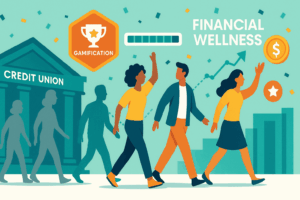Whether your credit union is already leveraging financial literacy programs or exploring a new program, this article will help you design, execute, and measure an effective program.
Introduction: Why Financial Literacy Matters for Credit Unions
Financial literacy isn’t just about budgeting—it’s a powerful tool for member engagement, retention, and growth. A survey by the National Financial Educators Council (NFEC) found that financial illiteracy costs the average American $1,819 per year (NFEC). Credit unions can bridge this gap by offering practical and accessible financial education that empowers members and attracts new ones.
1. The Business Case for Financial Literacy in Credit Unions
At their core, credit unions have a mission of service. While financial literacy fits squarely into that mission, we see many credit unions under invest in financial literacy. It’s not because credit union leaders don’t care, but because there’s often a lack measurement and attribution towards business outcomes.
📊 Why Financial Education Works
- Builds trust and credibility with members
- Strengthens long-term financial relationships
- Encourages the use of financial products like savings accounts and loans
💡 Example: Patelco Credit Union launched a digital financial wellness platform and saw 35% higher engagement, leading to improved member retention (Patelco Credit Union).
2. How to Design an Effective Financial Literacy Program
🎯 Identify Member Needs
Not all members have the same financial challenges. Segment your audience and tailor financial education accordingly. What a high school senior in a rural school needs help with is different than a single mom or grandparents facing when to retire.
✅ Key Member Segments & Topics:
- Young adults & students – Budgeting, credit building, student loan management
- Families & professionals – Homeownership, investment strategies, retirement planning
- Retirees – Estate planning, social security optimization
🏫 Partnering with Schools & Universities
Educating the next generation fosters early financial habits and positions the credit union as a trusted resource.
💡 Example: Suncoast Credit Union partnered with Florida schools to provide interactive financial literacy courses, leading to a 20% increase in student checking account sign-ups (Suncoast Credit Union).
3. Using Digital Tools to Enhance Engagement
📲 Mobile Apps & Online Courses
Technology makes financial education accessible and engaging. Providing mobile-friendly learning modules increases participation. It also offers opportunity to capture data that can be used to improve programming and engage post programming in a contextual way. Digital tools can be used standalone as self-service or as a part of live or guided programming.
📌 Best Practices:
- Offer bite-sized financial lessons with quizzes and interactive tools
- Integrate AI-powered financial coaching into mobile banking apps
- Connect with budgeting tools like YNAB
💡 Example: GreenPath Financial Wellness partnered with credit unions to integrate financial education into banking apps, increasing engagement by 28% (GreenPath).
4. Hosting Engaging Financial Literacy Events
🎤 Community Workshops & Webinars
Live events—whether in-person or virtual—enhance interaction and build trust. Having a set day and time can operate as a forcing function to get folks to attend. Nothing will replace the opportunity to connect with others in real time— capturing their undivided attention. Use that time to build a relationship with members and prospective members.
✅ Popular Topics:
- How to Improve Your Credit Score
- First-Time Homebuyer’s Guide
- Small Business Finance Tips
💡 Example: Addition Financial Credit Union hosted monthly financial wellness webinars, leading to a 15% increase in mortgage applications (Addition Financial).
5. Measuring Success & Improving Impact
Many financial literacy programs are doomed for failure despite how beneficial they are. The key to justifying any investment is showing the value and return on investment. Financial literacy programs are no exception. Credit union leaders, board members, and employees want to know that their efforts in these programs lead to outcomes that matter. Stories and anecdotes are great, the real power comes from tapping into data about the impact on participants financial literacy and impact on the business. Combine community and business impact and you’ll create effective programs.
📊 Key Metrics to Track
- Member engagement rates (workshop attendance, course completion)
- Product adoption rates (new savings accounts, loan applications)
- Retention & referral growth
💡 Example: A study by Filene Research Institute found that credit unions offering structured financial literacy programs saw a 25% increase in long-term member retention (Filene Research).
Conclusion: Financial Literacy as a Growth Strategy
Financial literacy programs are a win-win for credit unions and their members. By educating, engaging, and empowering members, credit unions can increase loyalty, drive product adoption, and attract new members. In fact, financial literacy programs are one of the purest forms of marketing and doing good for the community. Helping people achieve their personal and financial goals is rewarding for your credit union’s mission and bottomline.
Financial wellness isn’t just an offering—it’s a strategic growth driver. Is your credit union ready to leverage financial literacy for long-term success? 🚀








